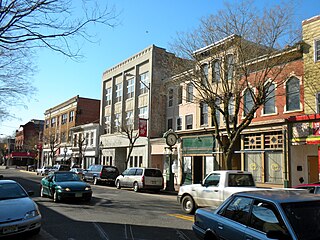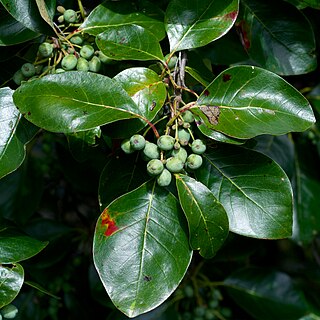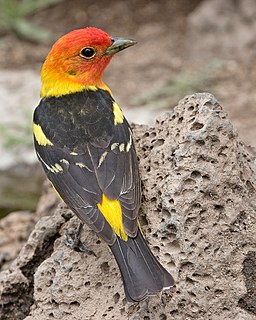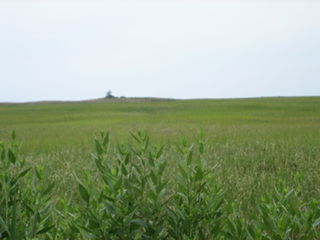Bear Swamp is a swamp in Cumberland County, southwestern New Jersey, notable for its 215 acres (87 ha) of old-growth forests and the birds they contain. It is divided into two areas, Bear Swamp East and Bear Swamp West, separated from each other by gravel mines and roads.

A swamp is a wetland that is forested. Many swamps occur along large rivers where they are critically dependent upon natural water level fluctuations. Other swamps occur on the shores of large lakes. Some swamps have hammocks, or dry-land protrusions, covered by aquatic vegetation, or vegetation that tolerates periodic inundation or soil saturation. The two main types of swamp are "true" or swamp forests and "transitional" or shrub swamps. In the boreal regions of Canada, the word swamp is colloquially used for what is more correctly termed a bog, fen, or muskeg. The water of a swamp may be fresh water, brackish water or seawater. Some of the world's largest swamps are found along major rivers such as the Amazon, the Mississippi, and the Congo.

Cumberland County is a county located in the U.S. state of New Jersey. As of the 2017 Census estimate, the county's population was 152,538, making it the state's 16th-largest county, representing a 2.8% decrease from the 156,898 enumerated at the 2010 United States Census, in turn increasing by 10,460 (+7.1%) from the 146,438 counted in the 2000 Census, retaining its position as the state's 16th-most populous county. Its county seat is Bridgeton. Cumberland County is named for Prince William, Duke of Cumberland. The county was formally created from portions of Salem County as of January 19, 1748.

New Jersey is a state in the Mid-Atlantic region of the Northeastern United States. It is a peninsula, bordered on the north and east by the state of New York, particularly along the extent of the length of New York City on its western edge; on the east, southeast, and south by the Atlantic Ocean; on the west by the Delaware River and Pennsylvania; and on the southwest by the Delaware Bay and Delaware. New Jersey is the fourth-smallest state by area but the 11th-most populous, with 9 million residents as of 2017, and the most densely populated of the 50 U.S. states; its biggest city is Newark. New Jersey lies completely within the combined statistical areas of New York City and Philadelphia and was the second-wealthiest U.S. state by median household income as of 2017.
Bear Swamp West contains broadleaf swamp forest dominated by black gum, American sweetgum, red maple, and sweetbay magnolia. Other trees present are American beech, swamp white oak, and American holly. Some 100 acres (40 ha) of this forest is old-growth filled with trees of impressive sizes and ages. The black gum are nearly 4 feet (120 cm) in diameter and 600 years old. The sweetgum again nearly 4 feet (120 cm) in diameter, and 300 years old. The red maple are over 4 feet (120 cm) in diameter. The American holly are particularly large, reaching 22 inches (56 cm) in diameter and 80 feet (24 m) tall.

Nyssa sylvatica, commonly known as Tupelo, Black gum, sour gum, is a medium-sized deciduous tree native to eastern North America from the coastal Northeast USA and southern Ontario south to central Florida and eastern Texas, as well as Mexico.
Bear Swamp East is in Belleplain State Forest. It covers 1,439 acres (582 ha) and contains 115 acres (47 ha) of old-growth forest. It has forests similar to Bear Swamp West, but with large Tulip Poplar on hummocks, some reaching 5 feet (150 cm) in diameter and 400 years of age.

Belleplain State Forest is a 21,320-acre (86.3 km2) New Jersey State Forest in northern Cape May County and eastern Cumberland County. It has many young pine, oak and Atlantic white cedar trees, having better soil than the northern Pine Barrens. It was established in 1928 and the Civilian Conservation Corps (CCC) set up camps here in 1933, converted Meisle Cranberry Bog into Lake Nummy and constructing the original forest headquarters, maintenance building, a road system, bridges, and dams.
A hummock is a small knoll or mound above ground. They are typically less than 15 meters in height and tend to appear in groups or fields. It is difficult to make generalizations about hummocks because of the diversity in their morphology and sedimentology. An extremely irregular surface may be called hummocky.
As many as 30 bald eagles nest in the swamp, and it is home to the oldest continuously occupied bald eagle nest in New Jersey. It is a breeding site for red-shouldered hawks, barred owls, and Cooper's hawks, all species of concern in the state. It is one of just two known breeding sites in southern New Jersey for pileated woodpeckers.

The bald eagle is a bird of prey found in North America. A sea eagle, it has two known subspecies and forms a species pair with the white-tailed eagle. Its range includes most of Canada and Alaska, all of the contiguous United States, and northern Mexico. It is found near large bodies of open water with an abundant food supply and old-growth trees for nesting.

The red-shouldered hawk is a medium-sized hawk. Its breeding range spans eastern North America and along the coast of California and northern to northeastern-central Mexico. Red-shouldered hawks are permanent residents throughout most of their range, though northern birds do migrate, mostly to central Mexico. The main conservation threat to the widespread species is deforestation.

The barred owl, also known as northern barred owl or hoot owl, is a true owl native to eastern North America. Adults are large, and are brown to grey with barring on the chest. Barred owls have expanded their range to the west coast of the United States and Canada, where they are considered invasive. Mature forests are their preferred habitat, but they are also found in open woodland areas. Their diet consists mainly of small mammals, but they are also known to prey upon other small animals such as birds, reptiles, and amphibians.


















